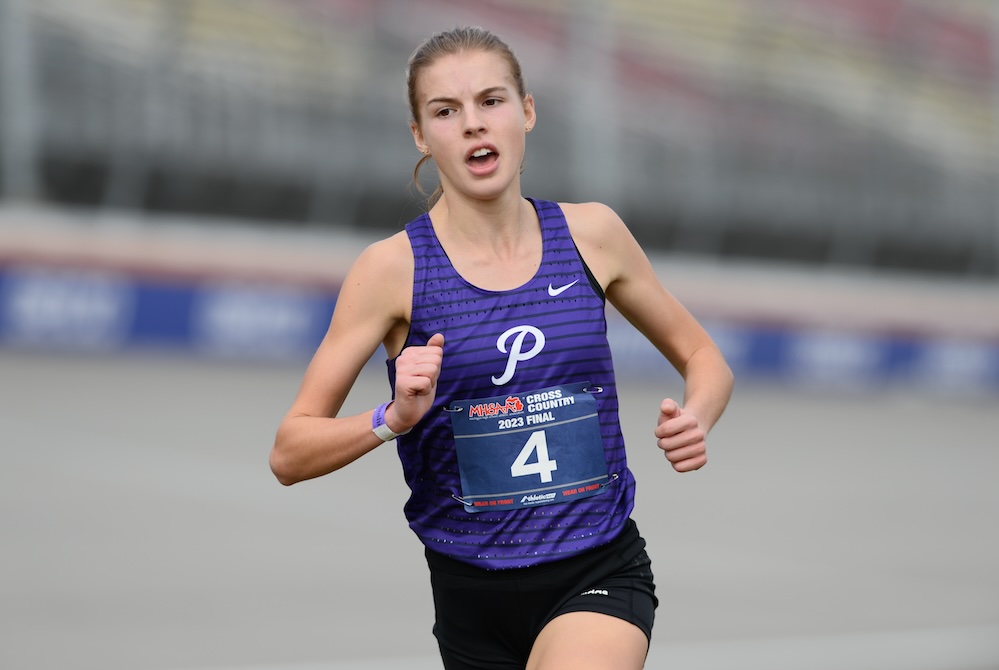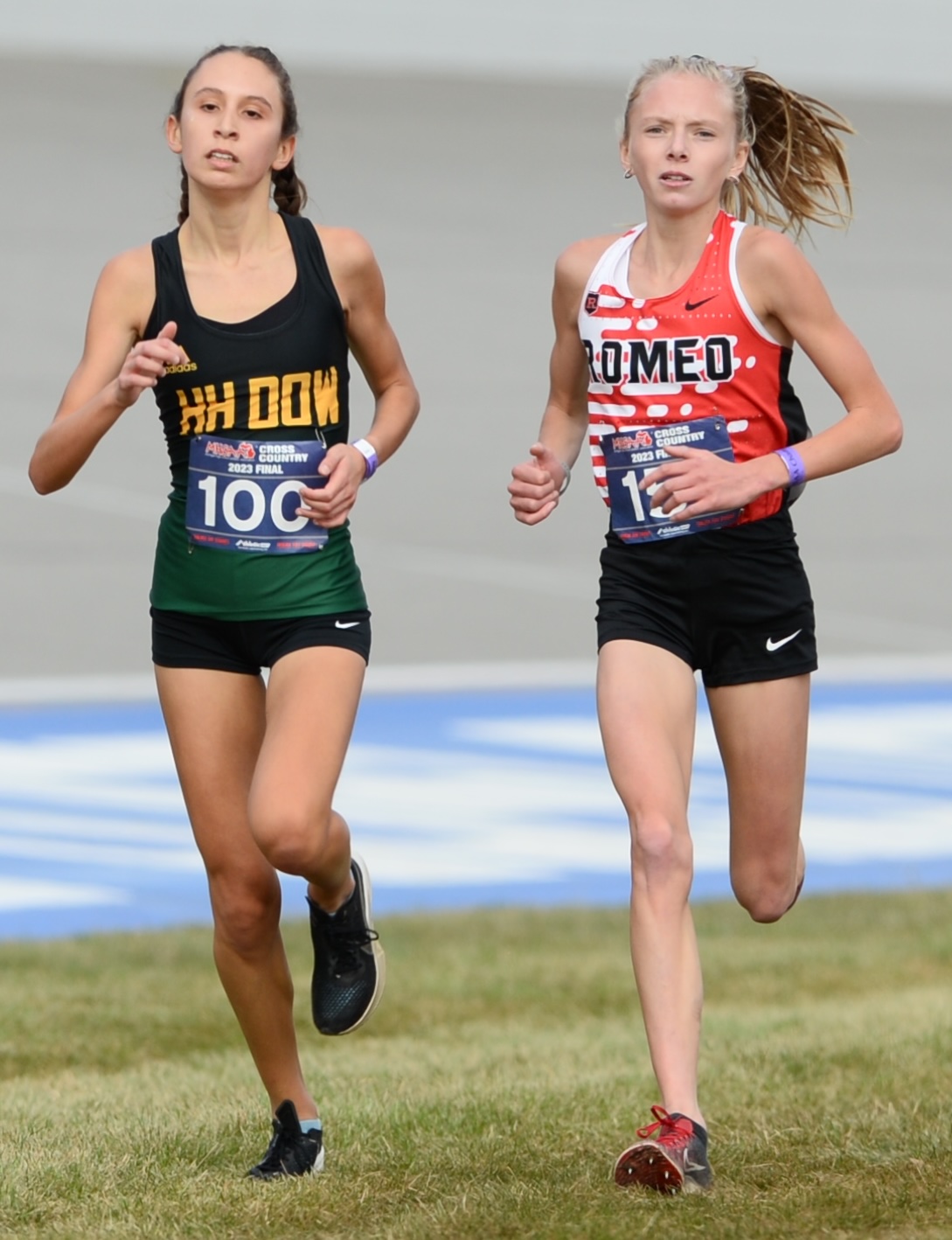
Forsyth Closes Career as Legendary, Romeo Caps Memorable 1st Title Run
November 4, 2023
BROOKLYN — Dathan Ritzenhein’s time of 14:10.4 at the 2000 MHSAA Cross Country Finals has become the stuff of legend.
During the 23 years that have followed, no other runners has come remotely close to breaking the record set by the three-time Olympian from Rockford.
Years from now, perhaps Rachel Forsyth’s performance Saturday at Michigan International Speedway will be just as revered.
She not only set the girls course record, she obliterated it.
Running solo from the gun, Forsyth ran a scorching 16:28.5 to shatter the course mark of Lansing Catholic’s Olivia Theis in the 2017 Division 2 race.
It’s worth noting that some of the greatest high school cross country runners in the country have graced MIS since the MHSAA moved its Finals there in 1996.
Megan Goethals of Rochester (2009) and Zofia Dudek of Ann Arbor Pioneer (2019) won Foot Locker national championships. Others have gone on to become college All-Americans.
It wasn’t even Forsyth’s fastest time this season. She ran 16:07.5 to win her Regional meet. Forsyth was more fixated on beating that time than taking down the course record.
 “I just handled it like a normal race,” Forsyth said. “Me and my friends goofed off. We got ready as we normally did. No one put too much pressure on it.”
“I just handled it like a normal race,” Forsyth said. “Me and my friends goofed off. We got ready as we normally did. No one put too much pressure on it.”
It was the second MHSAA championship for Forsyth, the other coming two years ago when she ran 17:09.32.
After that, she began to struggle with an eating disorder which put her life in jeopardy. She was hospitalized at the University of Michigan’s Mott Children’s Hospital and was then admitted to the Eating Recovery Center in Illinois.
She was finally healthy enough to rejoin her team on the race course in late September last year, but had lost much of her spectacular fitness. She finished 62nd in last year’s state meet.
“It’s very surreal, because I missed so much,” Forsyth said. “So, to be able to be at my best …”
At this point, Forsyth began choking up before she finished the sentence … “is very special.”
Forsyth said the process of making healthy decisions is still difficult, “but the benefits of doing what I have to pays off 100 percent.”
Forsyth reached the finish line before anyone else hit the three-mile mark in the 3.1-mile race. Finishing a distant second was Grand Rapids Ottawa Hills senior Selma Anderson, whose time of 17:13.6 would have ranked 11th in MIS history coming into a record-setting day across the board.
“It was pretty cool to watch, but I know I couldn’t run with her,” Anderson said. “So, I was just going to focus on my race.”
Forsyth hoped to cap her record-breaking day with a team championship celebration, but Romeo had something to say about that, putting up a winning total of 65 points to claim its first Finals championship and after finishing runner-up a year ago. Pioneer was second this time with 126 points.
Freshman Annie Hrabovsky of Romeo established herself as a future championship contender, placing fourth in 17:28.7. Sophomore Natalia Guaresimo was seventh, sophomore Emmerson Clor 13th, junior Lillian Deskins 22nd and junior Olivia Purdy 41st for Romeo.
The Bulldogs had four runners cross before Pioneer had two.
PHOTOS (Top) Ann Arbor Pioneer's Rachel Forsyth takes the final paces of her record-setting run Saturday at MIS. (Middle) Midland Dow's Victoria Garces (200) and Romeo's Annie Hrabovsky run side-by-side down the closing stretch. (Photos by Dave McCauley/RunMichigan.com.)

MHSAA Vault: MIS Rose to Challenges to Host 2020 LP Finals
By
Rob Kaminski
MHSAA benchmarks editor
November 12, 2021
The “MHSAA Vault” features stories from past publications and other documents in the MHSAA Library. This issue takes a look at the MHSAA Cross Country Finals at Michigan International Speedway, which celebrated 25 years in 2020 – although it was an event that nearly didn’t happen last fall …
In 1996, the MHSAA and Michigan International Speedway began a partnership the changed the course of the Lower Peninsula Cross Country Finals – quite literally.
The land in and around the track at Brooklyn would host the Finals for all classes of runners in one place on one day, an annual festival of nearly 2,000 runners competing for the MHSAA’s top honors.
Even skeptics – and there were several among running purists who thought the course was too flat, for example – can’t deny the results.
Finals attendance nearly doubled in that first year, and crowds in excess of 10,000 have enjoyed a day of racing several times, including a record 12,153 in 2011.
Enthusiastic crowds were the norm in recent years, with 11,232 in 2017, and nearly 11,000 in 2018 (10,989) and 2019 (10,873).
In fact, attendance failed to reach at least 8,000 only twice since the move to MIS.
Of course, last year was an exception, when attendance was limited to 1,000 spectators per session due to the COVID-19 Pandemic. Fans also were restricted to the grandstands rather than following the action throughout locations on the course.
To reduce the number of runners in each race, the event was spread over two days, with each Division being run in two separate “sections” with times then combined at the end to determine team and individual champions.
While not ideal, the end result was another year of fantastic efforts at MIS – both from student-athletes and those behind the scenes.
“Even at the last hour, less than a week ahead of the Finals, we were closer to not having the Finals than we were to having them,” said MHSAA Assistant Director Cody Inglis, who coordinates the cross country postseason. “Rumors and challenges of mandated shutdowns, testing and other requirements were being discussed and caused a lot of unknowns. Even at the Regional level, we had schools, Regional courses and hosts shutting down their facilities; we had to relocate four Regionals 48 hours prior to race times. That scenario just could not happen at the Finals level where far more runners and much more travel would be involved.”
Among the many last-minute hurdles was the edict from NASCAR – which owns MIS – that all persons on site be temperature checked upon entry. That meant securing thermometers that were easy to operate in short order, along with personnel necessary to conduct the readings.
The attendance limitations certainly helped to implement the temperature screening, but brought their own issues.
“Limiting spectators was not a popular decision, but it really was the only way to have a race,” Inglis said. “We were taking direction and working with policies and protocols from the MDHHS, the Governor’s office, Lenawee County Health Department, MIS and NASCAR.”
Part of the solution was to utilize the grandstands as a “barrier” between participants and spectators. The reduced number of fans were dispersed over thousands of seats while still allowing them the chance to watch their student-athletes compete.
“It wasn’t the same, it wasn’t easy or perfect, but it was what we had to do to have a race,” Inglis said. “Separating the Finals into two days and different sections also allowed us to spread out the event and limit the number of people on site at any one time. This was a key part of the plan and worked well even though it separated races within a Division.”
The MHSAA, MIS and the cross country community never lost focus of the main goal: a culmination of the season for the student-athletes, who deserved something last year more than ever. And, more than ever, MIS once again displayed its advantage as a venue that could adapt to the fluid nature of the times to pull off the event.
“There were some thoughts of using four different sites, but as we learned during the Regionals, the climate of things was so tenuous from one area of the state to another that we couldn’t be 100-percent certain that there wouldn’t again be last-minute cancelations,” Inglis said. “MIS was wonderful to work and collaborate with, and was the best option to get it done. It was never mentioned once publicly about the possibility of not having the Finals – only how we could best do it under uncharted conditions.”
The moving parts and ever-changing scenarios created more complexity than ever in finalizing a season, but every decision was made with the complete desire to conduct the Finals as close to normal as possible.
“I firmly believe that a finish to the season, no matter the differences in race formatting and fan experience, was something everyone would have taken when the season began in August,” Inglis said.
Indeed, the finish line in Year 25 at MIS might have been the most gratifying of them all.

